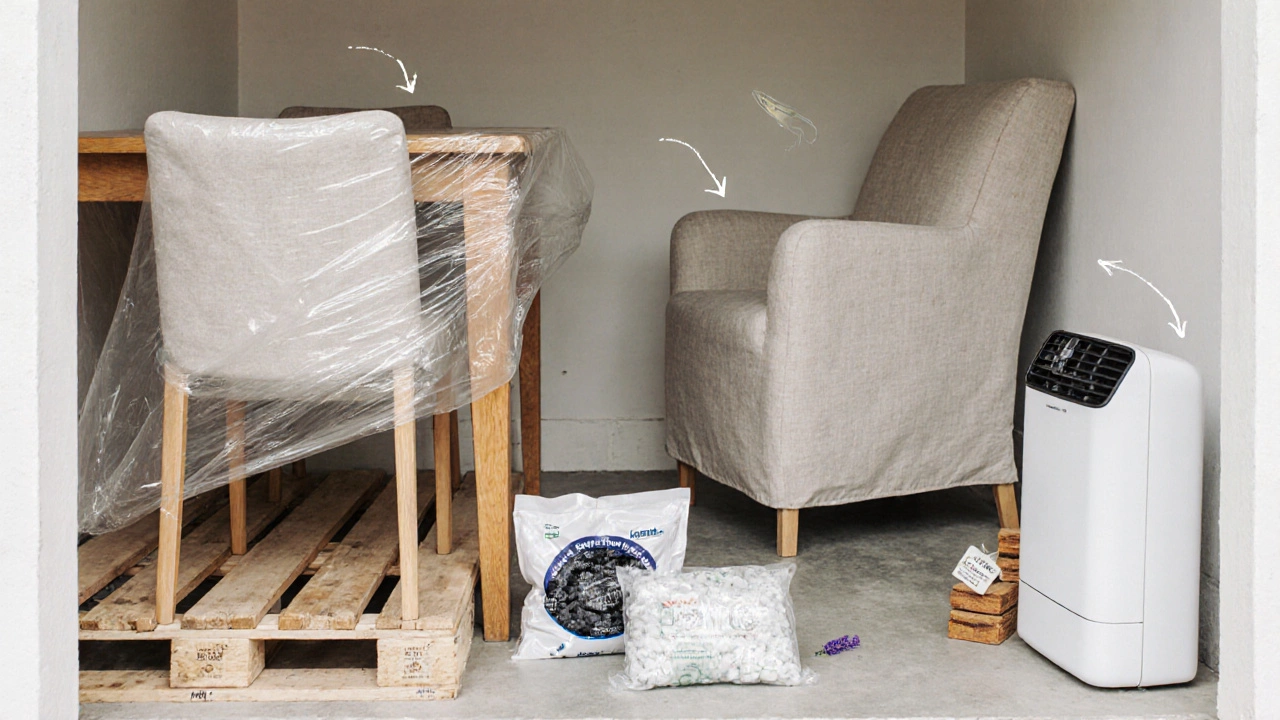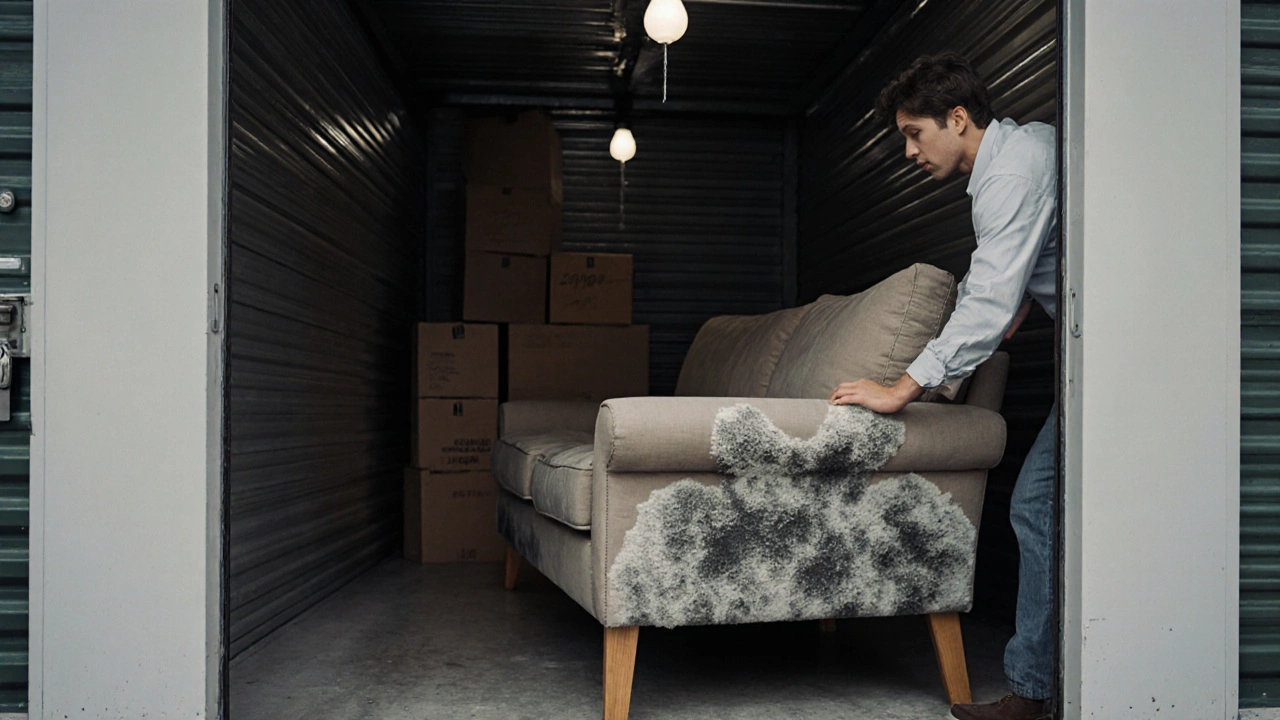Mold Risk Calculator
Furniture Storage Risk Assessment
Calculate your mold risk based on environmental conditions.
Results
Ever wonder if you’ll pull a sofa out of a storage unit only to find it covered in fuzzy spots? It’s a real fear for anyone who’s ever had to stash a favorite armchair or a set of dining chairs for a few months. The short answer is yes-furniture can get moldy in a storage container, but you can stop it before it starts.
Why Mold Shows Up on Furniture
Furniture is a collection of movable objects-chairs, tables, sofas, cabinets-that furnish a space and most pieces are made of wood, fabric, or a mix of both. Those materials love moisture. When humidity climbs above 60 % for several days, the organic fibers in wood or the cotton/linen blends in upholstery become a feeding ground for Mold a fungus that thrives in damp, warm environments and releases spores that cause discoloration, odor, and health issues. A storage container is essentially a sealed box, and unless you control the air inside, it can become a mini‑climate chamber where spores multiply unchecked.
Key Factors Inside a Storage Container
- Humidity: The biggest driver. Even a small leak in a metal unit can raise internal moisture levels.
- Temperature: Warm temps (above 70 °F) speed up mold growth. Cold slows it, but condensation can still form when warm air meets a cool surface.
- Airflow: Stacked items block circulation, creating pockets of stagnant, damp air.
- Material Exposure: Soft fabrics, unfinished wood, and particleboard are especially vulnerable.
Understanding these variables helps you choose the right prevention tactics.
How to Keep Your Furniture Mold‑Free
The goal is simple: keep the environment dry and well‑ventilated. Below are practical steps that work for most homeowners.
- Clean Before Storing: Dust off every surface with a dry cloth. For upholstered pieces, vacuum with an upholstery attachment to pull out dust that can hold moisture.
- Dry Thoroughly: If anything feels damp, let it air dry for at least 24 hours. Sunlight is a natural mold killer-place items outdoors on a bright day, but avoid direct UV on delicate finishes.
- Apply a Protective Barrier: Wrap wooden legs in Plastic Sheeting a thin, moisture‑resistant film used to shield items from water vapor or use a breathable furniture cover. For fabric pieces, consider a light‑weight, zip‑up cover that still lets air flow.
- Control Humidity Inside: Place a Dehumidifier an electrical device that extracts moisture from the air, lowering relative humidity in the storage unit (if you have power access). For units without electricity, use desiccants like Silica Gel granular silicon dioxide packets that absorb moisture or charcoal briquettes.
- Use Natural Repellents: Cedar wood blocks or lavender sachets can deter mold spores. They’re not a substitute for dehumidification but add a pleasant scent and a mild anti‑fungal effect.
- Monitor Moisture Levels: A cheap Moisture Meter a handheld device that measures relative humidity on surfaces or in the air lets you check the container weekly. Aim for under 55 % humidity.

Step‑by‑Step Prep Checklist
- Inspect each piece for existing stains or mildew. Treat any spots with a 1:1 mixture of water and white vinegar, then let dry.
- Disassemble where possible (remove legs, cushions, glass shelves) to increase airflow.
- Wrap wood components in plastic sheeting and secure with tape.
- Cover upholstery with a breathable garment-do not seal it airtight.
- Place desiccant packets on top of and around the items.
- Seal the container, but leave a small vent (a drilled hole with a breathable mesh) if the unit isn’t climate controlled.
- Check humidity after 48 hours and adjust desiccants or dehumidifier as needed.
Best Storage Options Compared
| Option | Humidity Control | Cost (per month) | Best For |
|---|---|---|---|
| Standard Metal Unit (no climate control) | Low - relies on external conditions; add desiccants | $30‑$45 | Short‑term moves, budget‑conscious |
| Climate‑Controlled Facility | High - maintains 45‑55 % RH automatically | $60‑$90 | Long‑term storage, valuable or antique pieces |
| Outdoor Shed (wooden) | Variable - prone to leaks, needs sealant & ventilation | $20‑$35 | DIY owners with space, willing to add moisture barriers |
| Portable Plastic Storage Box (sealed) | Medium - airtight; add silica gel to keep dry | One‑time $50‑$120 | Small items, short trips, moving vans |
When you weigh price against risk, a climate‑controlled unit usually wins for anything you care about. But if you’re on a shoestring budget, the combination of a standard unit, good wrapping, and plenty of desiccants can keep furniture mold at bay.

Common Mistakes & How to Fix Them
- Sealing Completely: An airtight box traps any residual moisture, creating a perfect mold incubator. Always leave a tiny vent or use breathable covers.
- Skipping the Clean‑Up: Dust and grime hold water. A quick vacuum and wipe‑down removes the fuel mold needs.
- Relying on One Desiccant Pack: Silica gel works, but it saturates fast. Replace or recharge packs every 2‑3 weeks for long stays.
- Stacking Without Spacing: Items pressed together block airflow. Use pallets or cardboard sheets to create gaps.
When to Call a Professional
If you notice a persistent musty smell after the first month, or if visible black spots appear despite your precautions, it might be time to bring in a restoration specialist. Professionals have industrial dehumidifiers and anti‑mold treatments that can salvage heavily affected pieces.
Quick Recap
To keep your furniture safe, remember the three‑step mantra: Clean, Cover, Control. Clean everything, wrap it in a breathable barrier, and manage humidity with dehumidifiers or desiccants. Check weekly, and you’ll pull out your pieces looking just as fresh as the day you stored them.
Will any type of furniture get mold in a storage unit?
All furniture made from wood, fabric, particleboard, or any porous material can develop mold if the environment is humid enough. Metal or glass items are less vulnerable, but they can still collect moisture on their surfaces.
How often should I check the humidity inside my storage container?
Weekly checks are ideal. Use a cheap moisture meter or a hygrometer attached to the container wall. If you see readings above 55 %, add more desiccants or run a portable dehumidifier.
Can I store furniture in a garage without worry?
Only if your garage stays dry and temperature‑stable. Most garages experience seasonal swings and occasional leaks, so treat it like a non‑climate‑controlled unit: wrap items, use silica gel, and monitor humidity.
Is cedar wood really effective against mold?
Cedar releases natural oils that inhibit fungal growth, making it a good supplemental shield. It won’t replace proper humidity control, but adding a few cedar blocks can reduce the risk.
What’s the difference between a dehumidifier and silica gel?
A dehumidifier is an electronic device that continuously pulls moisture from the air, ideal for larger spaces with power access. Silica gel packets are passive absorbers-great for sealed containers or short‑term storage where electronics aren’t feasible.

